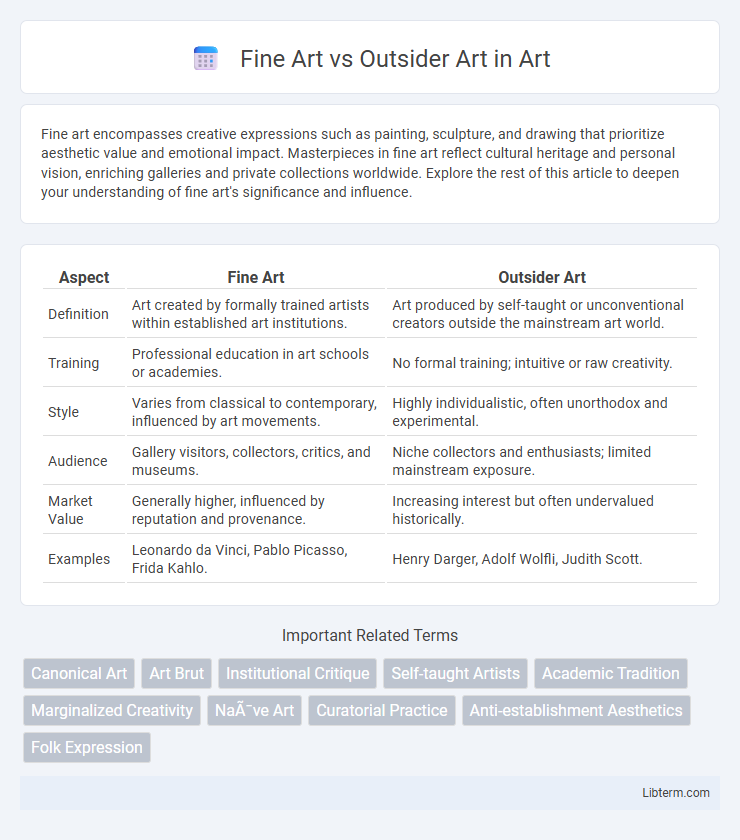Fine art encompasses creative expressions such as painting, sculpture, and drawing that prioritize aesthetic value and emotional impact. Masterpieces in fine art reflect cultural heritage and personal vision, enriching galleries and private collections worldwide. Explore the rest of this article to deepen your understanding of fine art's significance and influence.
Table of Comparison
| Aspect | Fine Art | Outsider Art |
|---|---|---|
| Definition | Art created by formally trained artists within established art institutions. | Art produced by self-taught or unconventional creators outside the mainstream art world. |
| Training | Professional education in art schools or academies. | No formal training; intuitive or raw creativity. |
| Style | Varies from classical to contemporary, influenced by art movements. | Highly individualistic, often unorthodox and experimental. |
| Audience | Gallery visitors, collectors, critics, and museums. | Niche collectors and enthusiasts; limited mainstream exposure. |
| Market Value | Generally higher, influenced by reputation and provenance. | Increasing interest but often undervalued historically. |
| Examples | Leonardo da Vinci, Pablo Picasso, Frida Kahlo. | Henry Darger, Adolf Wolfli, Judith Scott. |
Defining Fine Art: Tradition and Techniques
Fine Art embodies traditional artistic disciplines such as painting, sculpture, and drawing, emphasizing mastery of classical techniques and adherence to established aesthetic principles. It is often associated with academic training, formal art institutions, and historical art movements that have shaped Western art canons. Fine Art prioritizes refined craftsmanship and concept development, distinguishing it from more spontaneous or untrained artistic expressions.
What is Outsider Art? Origins and Characteristics
Outsider Art refers to works created by self-taught artists outside the conventional art world, often including individuals with no formal training or those marginalized by society. Originating in the early 20th century, the term gained prominence through French artist Jean Dubuffet, who used "Art Brut" to describe raw and uninfluenced creativity from psychiatric patients and marginalized individuals. Characterized by unconventional techniques, vivid expression, and a lack of concern for traditional aesthetics or art market trends, Outsider Art emphasizes personal vision and authenticity.
Historical Context of Fine Art vs Outsider Art
Fine Art traditionally refers to artworks created by academically trained artists within established cultural institutions, reflecting historical periods such as the Renaissance, Baroque, or Modernism. Outsider Art, also known as Art Brut, emerged in the mid-20th century, characterized by self-taught, marginalized creators outside mainstream art circles, often expressing raw, unconventional perspectives. The historical context highlights Fine Art's evolution through formal artistic movements, whereas Outsider Art challenges these conventions by emphasizing authenticity and outsider creativity.
Training and Education: Artists’ Backgrounds
Fine art artists typically undergo formal training through accredited institutions, acquiring technical skills and art theory knowledge essential for traditional mediums like painting and sculpture. Outsider artists often lack formal education, creating art driven by personal experiences and intuition rather than academic conventions. This distinction influences the techniques, themes, and originality present in each artistic approach.
Materials and Methods: Comparing Artistic Approaches
Fine Art traditionally employs established materials such as oil paints, marble, and canvas, emphasizing refined techniques developed through formal training. Outsider Art utilizes unconventional materials like found objects, scrap metals, and everyday items, reflecting spontaneous creativity unbound by academic standards. This contrast in materials and methods highlights divergent artistic approaches where Fine Art values mastery and tradition, whereas Outsider Art champions innovation and raw expression.
Popular Examples: Notable Fine Artists and Outsider Artists
Notable fine artists include Leonardo da Vinci, Vincent van Gogh, and Pablo Picasso, whose works epitomize classical techniques and mainstream recognition within established art institutions. Outsider artists like Henry Darger, Judith Scott, and Adolf Wolfli gained acclaim for their raw creativity, often creating art outside traditional academic training and art world networks. The contrast between fine art and outsider art highlights differences in formal education, cultural validation, and the influence of art market structures on an artist's visibility.
Gallery Representation and Market Value
Gallery representation of Fine Art typically involves established artists with formal training and recognized portfolios, attracting collectors willing to invest significantly, thus driving higher market value. Outsider Art, often created by self-taught or marginalized artists, gains gallery exposure through niche or specialized venues emphasizing authenticity and raw creativity, resulting in more variable but increasingly appreciated market value. The mainstream art market prioritizes Fine Art for its provenance and pedigree, while Outsider Art commands rising interest due to its unique narratives and growing collector demand, impacting market trends and valuation.
Cultural Impact: Influence on Contemporary Art Trends
Fine Art shapes contemporary art trends through established techniques, academic training, and market-driven aesthetics, influencing galleries and museums worldwide. Outsider Art, created by self-taught artists outside mainstream culture, introduces raw, unconventional perspectives that challenge artistic norms and inspire experimental approaches. The cultural impact of Outsider Art prompts reevaluation of artistic value and inclusivity, broadening the diversity of contemporary artistic expression.
Public Perception: Prestige and Accessibility
Fine Art is often associated with institutional prestige, showcased in renowned museums and galleries, which reinforces its status as culturally valuable yet less accessible to the general public. Outsider Art, created outside established art traditions, is perceived as more authentic and raw, appealing for its accessibility and emotional immediacy despite lacking mainstream recognition. Public perception favors Fine Art for its exclusivity and historical importance, while Outsider Art attracts audiences seeking unconventional creativity and personal expression.
The Future of Fine Art and Outsider Art
The future of Fine Art is increasingly marked by digital innovation and global accessibility, leveraging augmented reality and blockchain to enhance provenance and audience engagement. Outsider Art is gaining recognition for its raw authenticity and unique perspectives, prompting museums and galleries to expand their collections and blur traditional boundaries. Both art forms are converging through collaborative exhibitions and hybrid platforms, fostering a dynamic cultural ecosystem that values diversity and experimental expression.
Fine Art Infographic

 libterm.com
libterm.com